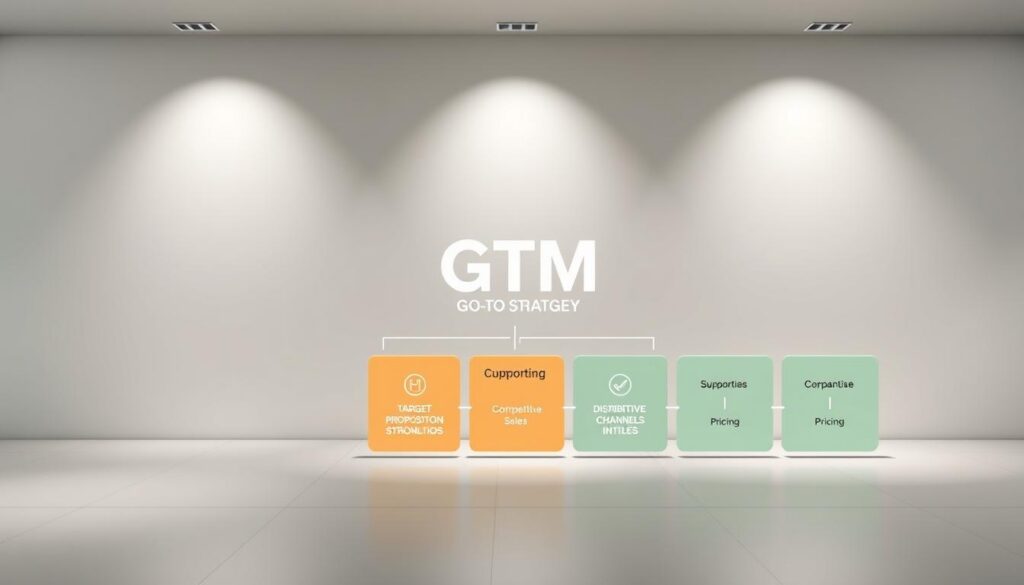A robust plan for commercializing offerings separates market leaders from competitors. This approach combines product development, customer insights, and sales processes into a cohesive roadmap for sustainable growth. Companies that master this alignment often see faster adoption rates and stronger customer loyalty.
Today’s dynamic business environment demands more than traditional product launches. Organizations must analyze competitive landscapes, identify high-value customer segments, and optimize distribution channels. Without this clarity, even innovative solutions risk becoming costly missteps.
The integration of cross-functional teams creates a multiplier effect. Marketing intelligence informs product refinements, while sales data shapes customer success initiatives. This synergy reduces financial risks and accelerates time-to-revenue.
Key Takeaways
- Align product positioning with measurable customer needs
- Leverage competitive analysis to refine value propositions
- Integrate marketing and sales workflows for consistent messaging
- Prioritize data-driven decision-making across business units
- Select distribution channels that match buyer preferences
- Develop metrics that track both adoption rates and profitability
This guide explores proven methods for transforming product releases into strategic growth opportunities. Subsequent sections provide actionable frameworks for optimizing each phase of market entry.
Introduction to Effective Go-to-Market Strategies
Businesses navigating crowded industries require more than just innovative ideas—they need a structured method to deliver value efficiently. A well-crafted approach ensures every team member understands their role in converting product potential into measurable results.
What Is a Strategic Market Entry Plan?
This type of plan acts as a roadmap for introducing offerings to specific audiences. It combines research on buyer behavior, competitor strengths, and ideal distribution methods. For example, companies might analyze regional purchasing patterns before selecting retail partners or digital platforms.
Why Structured Frameworks Matter
Clear methodologies reduce guesswork and financial risks. Teams gain:
- Faster product adoption through precise audience targeting
- Lower launch costs via optimized resource allocation
- Stronger customer relationships from aligned messaging
Organizations using these systems often achieve 30% shorter timelines for reaching revenue goals compared to unstructured efforts. The focus on data-driven decisions helps maintain agility in evolving markets.
Grasping the Fundamentals of GTM Strategy
Mastering market entry requires a blueprint that connects product development with buyer expectations. This framework bridges internal capabilities to external opportunities through five critical elements.

Understanding the Core Components
Effective GTM strategy rests on distinct pillars:
- Market definition: Identifies viable segments and competitive landscapes using growth potential analysis
- Customer profiles: Map decision-making behaviors beyond basic demographics
- Distribution models: Balance direct sales efficiency with partner network reach
- Product positioning: Translates technical features into measurable customer benefits
- Pricing architecture: Aligns costs with perceived value across buyer groups
GTM vs. General Marketing Strategy
While both approaches aim to drive growth, their focus differs:
- GTM strategy prioritizes launch-phase activities like channel selection and initial messaging
- Marketing strategy manages long-term brand perception and customer retention
For example, a software company might use GTM planning to coordinate beta testing with early adopters, while its broader marketing strategy nurtures user communities post-launch.
Elements of a Successful Go-to-Market Approach
Building a competitive presence demands three foundational pillars working in harmony. These elements transform theoretical plans into revenue-generating systems that resonate with buyers.
Defining Your Value Proposition
A compelling value statement answers “Why choose us?” with crystal clarity. It connects product capabilities to specific customer outcomes – like reducing operational costs by 18% or cutting project timelines in half. Teams at industry-leading consultancies often use problem-solution frameworks to articulate measurable benefits.
Identifying the Target Customer & Market
Effective targeting goes beyond basic demographics. Decision-makers analyze psychographic factors like risk tolerance and innovation appetite. For SaaS companies, this might mean focusing on mid-size firms with agile IT teams rather than enterprise clients burdened by legacy systems.
Optimizing Distribution and Channels
Channel selection directly impacts profitability. A hybrid approach combining direct sales for high-value accounts with digital platforms for broader reach often yields optimal results. Regular performance reviews ensure partners maintain quality standards and alignment with brand values.
Go to Market Implementation Strategies
Successful execution separates theoretical plans from revenue-generating operations. Organizations must adapt proven frameworks to their unique capabilities while maintaining alignment with core objectives.

Implementing Best Practices in Market Entry
Leading companies prioritize three operational principles when activating their market strategy. First, they match methodology to buyer behavior – content-driven approaches work for complex sales cycles, while product-led models suit self-service environments. Second, cross-functional teams establish clear metrics for each launch phase, tracking adoption rates and customer satisfaction simultaneously. Third, resource allocation follows data patterns rather than assumptions, ensuring optimal returns on marketing investments.
Real-World Examples and Case Studies
A cybersecurity firm achieved 157% year-over-year growth by combining account-based targeting with ecosystem partnerships. Their strategy focused on integrating complementary tools into enterprise IT stacks rather than pushing standalone solutions. Meanwhile, a productivity software provider reduced customer acquisition costs by 41% using product-led growth tactics. Free trial users received contextual guidance within the app, driving organic upgrades without aggressive sales outreach.
These cases demonstrate how tailored approaches outperform generic market entry plans. The key lies in selecting methods that amplify core strengths while addressing specific buyer needs through every interaction.
Crafting a Comprehensive Product Launch Plan
Strategic product launches demand precise coordination between development cycles and buyer expectations. A phased approach minimizes risks while maximizing market impact through controlled testing and data-backed adjustments.
Designing a Phased Launch Timeline
Effective timelines balance speed with adaptability. Begin with beta tests to validate core features among early adopters. Transition to soft launches in select regions, gathering feedback to refine pricing and support systems. Full-scale rollouts follow only after resolving critical pain points.
Key milestones include:
- Pre-launch team training and content creation
- Pilot program completion with measurable success criteria
- Channel partner onboarding completion dates
Developing Messaging and Buyer Personas
With 6.8 stakeholders typically involved in B2B purchases (Harvard Business Review), communication must address distinct roles. Gatekeepers need compliance details, while decision-makers seek ROI projections. Influencers respond to technical specifications and integration capabilities.
Tailor content formats accordingly:
- Case studies for budget holders
- Comparison guides for evaluators
- Implementation checklists for end users
Continuous message testing ensures alignment with evolving buyer priorities throughout launch phases. This iterative process turns product introductions into relationship-building opportunities rather than transactional events.
Building a High-Performance Go-to-Market Team
Assembling the right team composition accelerates market entry velocity. Cross-functional expertise ensures every launch phase addresses technical requirements, buyer needs, and operational realities. Core members typically include product specialists, customer success leaders, and pricing analysts working under a dedicated coordinator.
Roles and Responsibilities in a GTM Team
Clear role definitions prevent overlaps and gaps during product rollouts. Below are essential functions and their contributions:
| Role | Key Responsibilities | Impact |
|---|---|---|
| Product Management | Align features with market demands | Ensures technical-market fit |
| Sales Enablement | Create training tools & scripts | Boosts conversion rates |
| Customer Success | Design onboarding workflows | Reduces churn risk |
| GTM Manager | Track milestones & metrics | Maintains timeline integrity |
Collaboration and Cross-Functional Alignment
High-performing teams use weekly syncs to share updates and resolve bottlenecks. For example, product marketers might adjust messaging based on sales team feedback about customer objections. Shared dashboards display real-time adoption rates and support ticket trends.
A phased scaling approach works best. Start with 5-7 core members to establish workflows, then add specialists as launch complexity increases. Companies like those building expert software teams often use this model to balance agility with comprehensive coverage.
Successful collaboration relies on three principles:
- Single source of truth for all launch data
- Pre-defined escalation paths for conflicts
- Shared incentives tied to overall success metrics
Leveraging Data, Metrics, and Market Research for Growth
Modern businesses thrive on informed decisions rooted in measurable outcomes. Tracking performance indicators transforms abstract plans into actionable insights, creating feedback loops that drive continuous improvement.
Key Performance Indicators for Success
Critical metrics reveal what’s working—and what needs adjustment. Conversion rates expose funnel weaknesses, while customer lifetime value (CLV) highlights long-term profitability. Teams monitoring net promoter scores (NPS) gain early warnings about satisfaction dips before churn occurs.
Advanced analytics help optimize spending. By analyzing acquisition costs against revenue per customer, companies identify high-return channels. One study shows data-driven firms are 23x more likely to acquire customers.
Refining Strategy Through Insights
Predictive models turn historical patterns into forward-looking adjustments. A SaaS company might shorten sales cycles by aligning pricing with usage data. Retailers often adjust inventory based on regional buying trends uncovered through market research.
Regular metric reviews keep strategies aligned with shifting demands. This approach turns raw numbers into competitive advantages, ensuring growth plans remain responsive to real-world conditions.
FAQ
How does a go-to-market strategy differ from standard marketing plans?
Unlike broad marketing strategies focused on brand awareness, GTM strategies target specific product launches with measurable outcomes. They align sales, pricing, and customer education – like Adobe’s phased rollout for Creative Cloud subscriptions – to drive immediate market penetration.
What core elements make GTM strategies succeed in competitive markets?
Three pillars drive success: razor-sharp buyer personas (see HubSpot’s template library), value-based pricing models like Slack’s freemium approach, and channel optimization – exemplified by Warby Parker’s hybrid online/retail distribution.
Why do 43% of product launches underperform without proper GTM planning?
Common pitfalls include misaligned teams (sales vs. product timelines), generic messaging that fails to address specific pain points, and inadequate pre-launch testing. Salesforce’s Trailhead platform succeeded by validating training needs with early user groups.
How long should enterprise GTM implementation take?
Complex B2B launches typically require 6-9 months for market research, pilot programs, and sales enablement. Microsoft’s Azure Stack deployment followed this timeline, incorporating partner feedback loops before full release.
Which metrics prove GTM strategy effectiveness post-launch?
Track adoption rate (Dropbox’s referral-driven growth), customer acquisition cost, and feature usage patterns. Twilio’s API analytics dashboard provides real-time insights into developer engagement metrics.
Can startups use enterprise-grade GTM frameworks effectively?
Absolutely. Scalable tools like Drift’s conversational marketing platform help small teams execute account-based strategies. The key is focusing on niche verticals first – Zoom targeted education sectors before expanding enterprise-wide.



